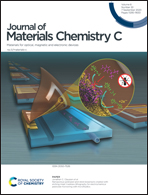Intrinsic mechanical properties of the polymeric semiconductors†
Abstract
Intrinsic flexible polymeric semiconductors are the most potential active candidates in flexible optoelectronics for their solution-processing ability, dynamic programmable mechanical property and excellent optoelectronic behaviour. Flexible optoelectronics including stretchable films, flexible crystals, and foldable and healable devices have recently received extensive attention in organic optoelectronics research, but an effective and universal strategy to precisely and systematically explore and evaluate the intrinsic mechanical properties of polymeric semiconductors have been rarely reported. Herein, we demonstrate a universal and convenient three-parameter model for a nano-indentation test to systematically evaluate the intrinsic mechanical properties of polymeric semiconductors. Significantly different from the previous assumption about the substrate effect in the nano-indentation test, we observed a critical testing depth (CTD) with a thickness ratio of <10% to obtain accurate mechanical parameters such as hardness (H) and Young's modulus (Er). To systematically investigate the mechanical behaviour, three-parameter models are also introduced to obtain the proportion of elastic and plastic works. The entanglement of main chains and side chains will provide excellent flexibility and viscoelasticity to polymeric semiconductors. Therefore, there is an urgent need to develop an effective molecular design strategy to obtain a viscoelastic rigid polymeric semiconductor for flexible optoelectronics, which exhibits slight viscoelasticity and simultaneously enhances the stable optoelectronic property in solid states.



 Please wait while we load your content...
Please wait while we load your content...